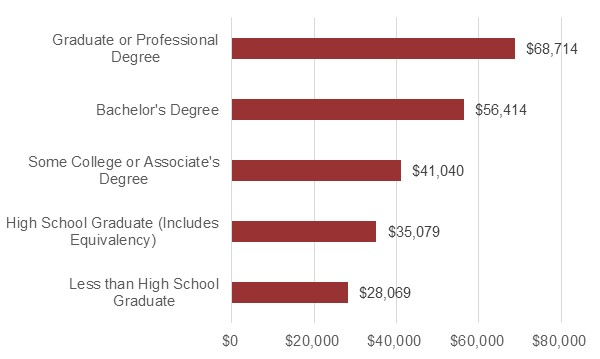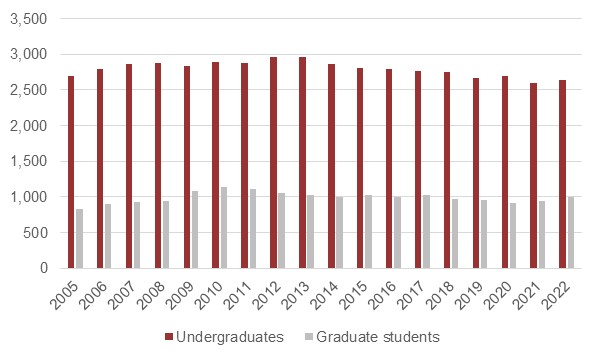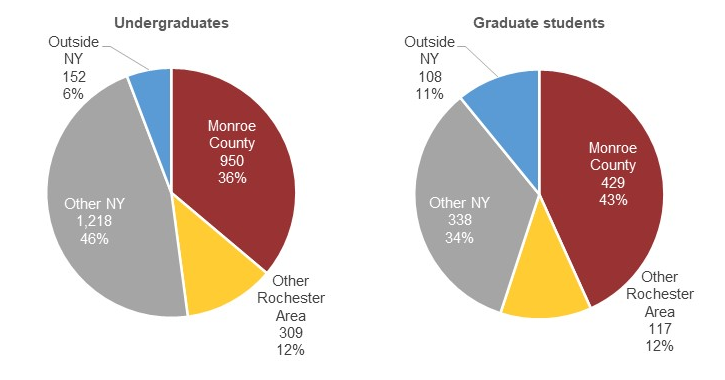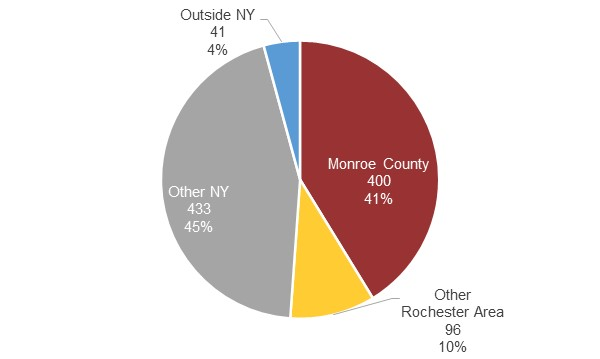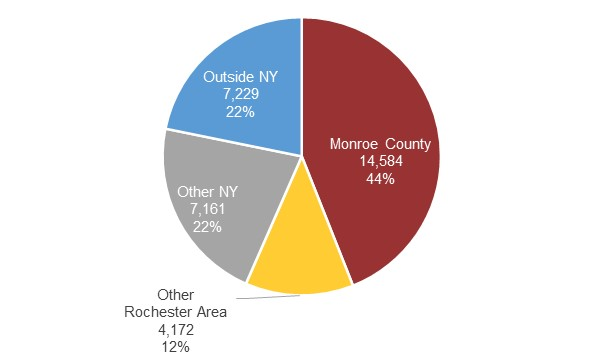Contributing to the Development of New York’s Human Capital
Human capital – the accumulated knowledge, skills and experiences of a city’s, a region’s, or a state’s workforce – is perhaps the single most important contributor to economic growth.
In this section:
- Student Enrollment at Fisher
- Making A Fisher Education More Affordable and Accessible
- Preparing Fisher Students for Tomorrow's Economy
- Where Fisher Alumni Live
- The Value of a Fisher Education
Data published by the U.S. Census Bureau highlight the impact of education on individual workers’ earnings. As Figure 6 shows, in 2021, the median annual earnings of Monroe County residents who had completed four-year college degrees were 60.8 percent higher than the median earnings of those who had only a high school diploma; and the median earnings of those with graduate or professional degrees were 95.9 percent higher than the earnings of those with no education beyond high school.
Source: 2021 American Community Survey (1-Year Estimates), U.S. Census Bureau; Social Explorer
The economic benefits of higher education, however, are not limited to those who earn degrees. A study published by the Milken Institute in 2013 found that in U.S. metropolitan areas, adding one year of schooling to the educational attainment of workers who already had a high school diploma increased average GDP per capita by 17.4 percent and average real wages by 17.8 percent.3 Educational attainment affects job growth as well. A recent study by the Boston Planning and Development Agency found that “metro areas with a ten percent higher share of adults with bachelor’s degrees in 2000 saw an average annual rate of job growth that was 0.3 percentage points higher from 2000 to 2016.”4
Even non-college educated workers benefit from this effect. University of California economist Enrico Moretti has shown that “the earnings of a worker with a high school education rise by about 7 percent as the share of college graduates in his [metropolitan area] increases by 10 percent.”5
Student Enrollment at Fisher
In the fall of 2022, a total of 3,621 students were enrolled in for-credit programs at St. John Fisher University, including 2,629 undergraduates and 992 graduate students.
As shown in Table 9, 41.8 percent of all Fisher undergraduates were enrolled in the School of Arts and Sciences, 27.2 percent were enrolled in the Wegmans School of Nursing, 20.2 percent in the School of Business, and 7.0 percent in the Ralph C. Wilson, Jr. School of Education. Among graduate students, 41.6 percent were enrolled in the Wegmans School of Nursing, 30.2 percent were enrolled in the Wegmans School of Pharmacy, 18.1 percent in the School of Education, 7.7 percent in the School of Business, and 2.3 percent in the School of Arts and Sciences.
Table 9: For-credit Enrollment
Total for-credit enrollment at Fisher by school, fall 2022
| School | Undergraduate students | Graduate students |
| School of Arts and Sciences | 1,098 | 23 |
| School of Business | 532 | 76 |
| Ralph C. Wilson, Jr. School of Education | 184 | 180 |
| Wegmans School of Nursing | 714 | 413 |
| Wegmans School of Pharmacy | 9 | 300 |
| Undeclared/non-matriculated | 92 | – |
| Total | 2,629 | 992 |
As shown in Figure 7, between the fall of 2005 and the fall of 2022, total for-credit enrollment at Fisher grew by 2.8 percent. Graduate student enrollment grew by 19.8 percent (an increase of 164 students), while undergraduate enrollment decreased slightly by 2.5 percent (a decrease of 67 students).
The majority of students enrolled at Fisher are residents of New York. In the fall of 2022, 1,379 students (38.1 percent of total enrollment) were from Monroe County, 426 students (11.8 percent of total enrollment) were from elsewhere in the Rochester area, and 1,556 students (43.0 percent) were from elsewhere in New York. Figure 8 shows the distribution of Fisher undergraduate and graduate students by place of residence.
Making a Fisher Education More Affordable and Accessible
The University provides several programs as part of its commitment to expanding access to a Fisher education.
Financial aid that St. John Fisher University provides from its own resources helps to ensure that students can get access to the educational opportunities Fisher offers. In fiscal year 2023, Fisher provided $44.8 million in University-funded financial aid to undergraduate students, including nearly $15.5 million to students from Monroe County, nearly $4.9 million to students from elsewhere in the Rochester area, and $21.3 million to students from elsewhere in New York.
The following programs are just a few examples of the University’s commitment to expanding access to a Fisher education.
- Fisher is particularly committed to providing opportunities for “first-generation” students. Created in 1998 to mark the 50th anniversary of Fisher’s founding, the Fannie and Sam Constantino First Generation Scholarship Program each year selects up to 24 high-potential, highly motivated high school seniors whose parents did not graduate from a postsecondary institution. The program provides yearly financial assistance for one-half the total cost of tuition and on-campus room and board. First Generation Scholars also participate in a “learning community” designed to help them succeed in making the transition from high school to college.
- Launched in the fall of 2020, the Fisher Urban Scholars Initiative aims to help make a Fisher education more affordable to incoming first-year undergraduates from the City of Rochester. The scholarship, which is open to any high school student who resides in the City of Rochester and enrolls at Fisher as a first-year student, provides $40,000 per student over the course of four years.
- Launched in 2020, St. John Fisher University’s Community Education Partner Program is aimed at expanding access to Fisher graduate programs for Rochester-area employees. The program provides a 20 percent tuition discount to select employees of partner companies and community organizations who enroll in select graduate programs in Fisher’s School of Arts and Sciences, School of Business or School of Education. Currently, more than 40 organizations take part in the program.
The University has also secured external funding to support students to include notable Federal and State grants for students.
- Fisher enrolls a significant number of low-income students. Approximately 28 percent of its undergraduate students received Pell grants during the 2020-21 academic year, which typically go to students with exceptional need, in the bottom 40 percent of the income distribution. Fisher is not only committed to enrolling low-income and first-generation students, but also to ensuring their success. According to the most recent data from the U.S. Department of Education, graduation rates for low-income students closely track graduation rates for all undergraduate students at Fisher. Sixty-nine percent of all Fisher students receiving Pell grants graduated within six years from their first enrollment at Fisher, as compared with 78 percent of all undergraduate Fisher students.6
- Fisher has effectively implemented the following grant-funded programs: New York State (NYS)-funded Arthur O. Eve Higher Education Opportunity Program (HEOP), National Science Foundation S-STEM, NYS Education Department C-STEP, and U.S. Department of Education TRIO SSS.
Preparing Fisher Students for Tomorrow’s Economy
A Strong Undergraduate Foundation
Undergraduate education at St. John Fisher University combines a strong grounding in the liberal arts with opportunities for students to pursue their career interests. Fisher offers a wide range of undergraduate programs that are closely aligned with some of New York’s leading (and in some cases, fastest-growing) industries. The following are just a few examples.
- Fisher’s School of Arts and Sciences offers a B.S. in cybersecurity, a rapidly growing industry that has become increasingly critical for all industries. Launched in the spring of 2020, the program combined courses in computer security, database management, cyberlaw, malware analysis, cloud security and more. Students also have the opportunity to gain practical experience assessing digital threats in labs using the tools and techniques used by professionals in the field.
- The Wegmans School of Nursing’s traditional nursing B.S. program trains its students “to provide exceptional patient- and family-centered care” through a combination of classroom learning and hands-on practice. Students are required to fulfill at least 840 hours of clinical experience, most of which takes place with Rochester-area health care providers. Students also gain training experience through the School’s Glover-Crask Simulation Center, a 10,400-square foot space that mirrors a hospital unit. In 2023, 94.22 percent of graduates of the Wegmans School of Nursing passed the National Council Licensure Examination (NCLEX) for registered nurses on their first attempt, putting Fisher in the top five percent of all New York schools.
- Fisher’s minor in Spanish/Latino culture for health professionals provides students with the skills needed to thrive in an increasingly multilingual and multicultural work environment. Developed jointly by the departments of nursing, modern languages and culture, and sociology, the program combines courses in Spanish language, Latino cultural practice, specialized health-related vocabulary, and community health issues. The program finishes with a community health internship experience in a Spanish-speaking health-related facility. The program is also offered as a certificate option for individuals who are currently employed or seek employment in a health care setting. The 15-credit certificate program follows the same curriculum as the minor, with the participant’s current work experience taking the place of the internship.
- The School of Arts and Sciences’ B.A. in sustainability provides students with the interdisciplinary knowledge and skills necessary to address “the economic and societal issues related to sustainability” – an increasingly important factor for organizations across all sectors and industries. Through a combination of courses in environmental studies, economics and public policy, students learn about the theory and practice of sustainability in a wide range of disciplines, including business, biology, economics, sociology, ethics and more. Students gain practical experience through the program’s required community-engaged sustainability experience, in which students spend 150 hours working to address a current sustainability issue with a community partner.
- Launched in the fall of 2022, the School of Arts and Sciences’ B.S. in athletic performance provides students with a science-based background in “promoting health and improving athletic performance.” The interdisciplinary program includes courses in areas such as nutrition, sports psychology, anatomy and physiology, motivation and performance, and cultural competency. Upon graduation, students will be prepared to pursue careers in several sectors, including sports rehabilitation, health care, sports psychology, fitness facilities, functional strength coaching and corporate wellness.
- Fisher offers a major or minor in data analytics, with courses in computing and programming, statistics, probability, and data skills. Students are required to complete a “mini-capstone” project in which they apply the techniques of data science to their major fields of study.
In-Demand Graduate and Professional Programs
Fisher's graduate and professional programs similarly prepare students for high-demand, rewarding, and critically important careers.
- The Wegmans School of Pharmacy is one of only eight pharmacy colleges in New York, and the only such program in Monroe County. The School’s Doctor of Pharmacy (Pharm.D.) degree is a four-year, full-time program integrating knowledge of the pharmaceutical sciences, clinical pharmacy and patient care with 2,000 hours of hands-on practical pharmacy experiences. Graduates of the program regularly outperform the national average on licensure exams, and nearly 100 percent of graduates consistently report employment after graduation.
- Launched in the fall of 2020, the Wegmans School of Pharmacy’s Fisher Pharm.D. Online program – which is the first online or hybrid Pharm.D. pathway in the state – follows the same curriculum as the School’s on-campus program, with a combination of online courses, selective on-campus immersions and clinical rotations at pharmacy locations in the students’ local communities. This innovative pathway – one of only a few of its kind in the U.S. – makes pharmacy careers more available to students from New York and around the country who for various wish to pursue their studies online at Fisher.
- The Wegmans School of Nursing offers an M.S. in nursing that prepares students to work as nurse practitioners or clinical nurse specialists. Students can choose to specialize in family primary care, adult primary or acute care, or psychiatric mental care. The School also offers undergraduate nursing students at Fisher the option to pursue a “Fast-Track B.S. to M.S.” option, in which students have to opportunity to take graduate-level courses during their senior year of undergraduate study.
- Launched in 2008, the Wegmans School of Nursing’s Doctor of Nursing Practice (DNP) program is designed to prepare students for advanced nursing practice, clinical scholarship, and leadership positions in health care organizations. The program offers both full- and part-time options and is available to both holders of a bachelor’s degree or a master’s degree in nursing. Students on the post-master’s track can complete the program in six semesters of full-time study, while students on the post-baccalaureate track can complete the program in three years of full-time study.
- Fisher’s School of Business, AACSB accredited, offers an Online MBA program with concentrations in accounting, general management, health systems management, and the pharmaceutical industry. Offered fully online, the 30-credit program can be completed within one year.
- The Ralph C. Wilson, Jr. School of Education offers an online M.S.Ed. in educational leadership designed to prepare teachers and other school professionals for leadership positions at either the school or the school district level.
- Since 2006, the School of Education has also offered an Ed.D. in executive leadership, an innovative doctoral program designed for working professionals in which classes are held every other weekend. Fisher’s program is also offered on the Iona University campus in Westchester County, NY.
Where Fisher Alumni Live
As of the summer of 2023, 78.2 percent of all Fisher living alumni (25,917 living alumni) lived in New York. As shown in Figure 10, 44.0 percent of all living Fisher alumni (14,584 alumni) lived in Monroe County, 12.6 percent (4,172 alumni) lived elsewhere in the Rochester area, and an additional 21.6 percent (7,161 alumni) lived elsewhere in New York.
Based on 2021 American Community Survey data, we estimate that graduates of St. John Fisher University account for approximately 6.8 percent of all residents of Monroe County who have at least a bachelor’s degree.7
The Value of a Fisher Education
The value of a St. John Fisher University degree is reflected in survey data on post-graduation experiences of Fisher undergraduate students. According to Fisher’s First Destinations Survey, 87 percent of the class of 2022 reported that they were either employed, continuing education, volunteering, in military service, or taking a gap year.8
The value of a St. John Fisher University undergraduate education is also reflected in the earnings of its graduates. According to PayScale’s annual report on the earnings of college graduates, in 2022:
- The median early career salary of Fisher alumni who only received a bachelor’s degree was $51,900; and
- The median mid-career salary of Fisher alumni who only received a bachelor’s degree was $93,200.9
3Ross DeVol et al., A Matter of Degrees: The Effect of Educational Attainment on Regional Economic Prosperity, The Milken Institute, February 2013, p.1.
4Boston Planning and Development Agency, Boston's Economy 2019, September 2019, p. 17.
5Enrico Moretti, The New Geography of Jobs, (New York: Houghton Mifflin Harcourt, 2012), p. 98.
6U.S. Department of Education, Institute of Education Sciences, National Center for Education Statistics, IPEDS: Integrated Postsecondary Education Data System.
7U.S. Census Bureau, 2021 American Community Survey (1-Year Estimates), Social Explorer.
8St. John Fisher University, Class of 2022 First Destinations Summary Report.
9PayScale, 2021-22 College Salary Report.
